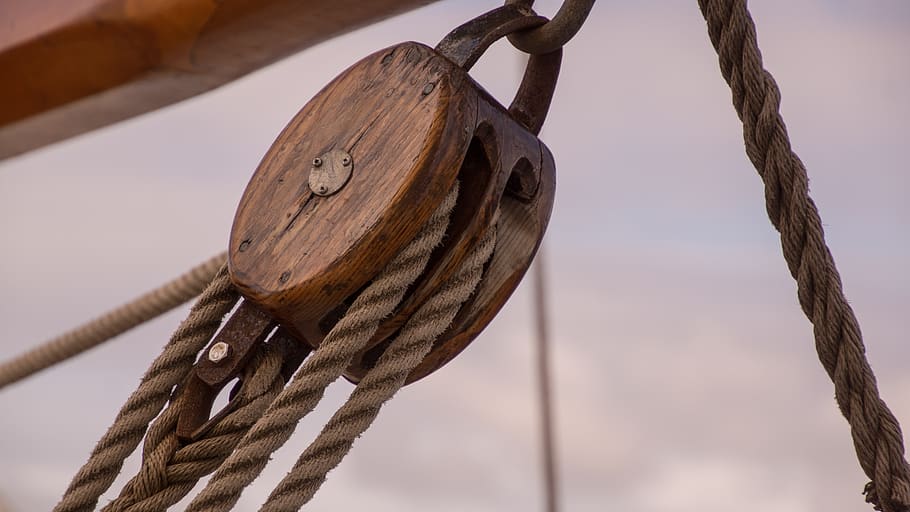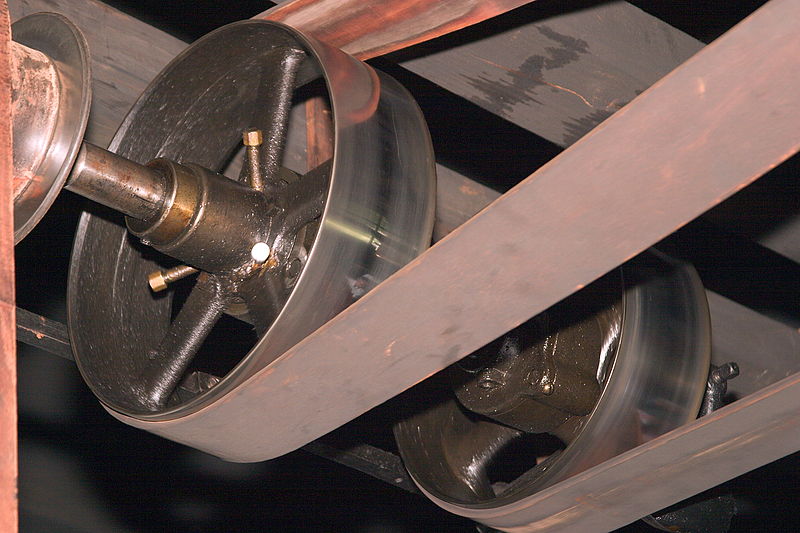Pulley
|
This photograph shows a rope and pulley (or block and tackle) system. |
Contents |
[edit] Introduction
A pulley is a type of wheel system is used with an axle to support the movement of some type of load.
[edit] History
The earliest recorded existence of pulley systems appeared in Ancient Egypt, Mesopotamia and Greece where block and tackle configurations were commonly used to move heavy objects.
During the Renaissance, this system was included by scientists in their list of six simple machines. According to Galileo Galilei, the simple machines “do not create energy, only transform it.” In addition to the pulley, these machines included:
- Lever
- Wheel and axle
- Inclined plane
- Wedge
- Screw
The six simple machines often served as the basis for more complex machines.
[edit] Types of pulleys
There are several types of pulley:
- Fixed. A fixed pulley has an axle mounted in bearings attached to a supporting structure.
- Movable. A movable pulley is made up of an axle in a movable block. A single movable pulley can lift more than a single fixed pulley.
- Compound. This combination of fixed and movable pulleys is also known as rope and pulley or block and tackle. When a fixed pulley is combined with a movable pulley or another fixed pulley, it can achieve more ambitious mechanical goals.
[edit] Rope and pulley
When used in combination with a frame or shell (sometimes referred to as a block), the freely rotating movable pulley (or set of pulleys) may be referred to as a sheave. The pulley or sheave may have indentations or grooves around its circumference to accommodate a drive element (sometimes referred to as a tackle) in the form of a continuous cable, belt, rope or chain. The tackle transmits tension to move a load.
This combination of rope and pulley can be part of a simple system that is used to lift items or change the direction of their motion. With the aid of a block and tackle system, it is possible to lift heavy loads by the application of a relatively small amount of force.
There are different types of rope and pulley configurations. The variations are based on the tackle configuration. Increasing the number of pulleys and falls of tackle increases the load that can be moved. Pulleys can be incorporated into common items such as curtains and sliding doors or lifting equipment such as fire ladders or power–driven industrial trucks and so on.
[edit] LOLER and rope and pulley systems
The Lifting Operations and Lifting Equipment Regulations (LOLER) place legal duties and responsibilities on those who own, operate or have control over lifting equipment. Rope and pulley systems are one type of lifting equipment covered by the regulations.
LOLER was created under the Health and Safety at Work etc. Act 1974, and came into force in 1998, replacing several preceding pieces of legislation which had previously regulated the use of lifting equipment. LOLER defines lifting equipment as ‘work equipment for lifting or lowering loads and includes its attachments used for anchoring, fixing or supporting it.’
The regulations require:
- That lifting equipment is strong and stable enough for safe use.
- Equipment is marked to indicate safe working loads.
- Equipment is positioned and installed so as to minimise risks.
- A competent person plans, organises and performs the safe use of the equipment.
- Equipment is subject to ongoing thorough examination and inspection.
LOLER may not apply where a lift is not used by people at work (such as a lift in a shop used by customers). However, Section 3 of the Health and Safety at Work Act imposes general responsibilities for the safety of users.
LOLER requires that lifts are thoroughly examined by a competent person at least every six months or, in the case of goods-only lifts, every 12 months. Insurance companies will generally request that a third party independent inspector carries out the inspections. The minimum requirements are:
- Every six months for lifting equipment used for lifting/lowering persons.
- Every six months for lifting accessories.
- Every 12 months for all other lifting equipment not falling into either of the categories above.
[edit] Belt and pulley
Another use of the pulley is the belt and pulley system. This system uses a pulley in conjunction with a belt drive to direct power from one place to another. The belt and pulley system can also control the speed of the motion.
|
This photograph shows a belt and pulley system. |
This configuration consists of two or more pulleys used in conjunction with a belt. The necessary contact pressure between the belt and pulleys is ensured by appropriate tightening of the belt. This may be achieved by means of a tensioning roller or another pulley.
[edit] Related articles on Designing Buildings Wiki
Featured articles and news
Government consultations for the summer of 2025
A year of Labour, past and present consultations on the environment, the built environment, training and tax.
CMA competitiveness probe of major housing developers
100 million affordable housing contributions committed with further consultation published.
Homes England supports Greencore Homes
42 new build affordable sustainable homes in Oxfordshire.
Zero carbon social housing: unlocking brownfield potential
Seven ZEDpod strategies for brownfield housing success.
CIOB report; a blueprint for SDGs and the built environment
Pairing the Sustainable Development Goals with projects.
Types, tests, standards and fires relating to external cladding
Brief descriptions with an extensive list of fires for review.
Latest Build UK Building Safety Regime explainer published
Key elements in one short, now updated document.
UKGBC launch the UK Climate Resilience Roadmap
First guidance of its kind on direct climate impacts for the built environment and how it can adapt.
CLC Health, Safety and Wellbeing Strategy 2025
Launched by the Minister for Industry to look at fatalities on site, improving mental health and other issues.
One of the most impressive Victorian architects. Book review.
Common Assessment Standard now with building safety
New CAS update now includes mandatory building safety questions.
RTPI leader to become new CIOB Chief Executive Officer
Dr Victoria Hills MRTPI, FICE to take over after Caroline Gumble’s departure.
Social and affordable housing, a long term plan for delivery
The “Delivering a Decade of Renewal for Social and Affordable Housing” strategy sets out future path.
A change to adoptive architecture
Effects of global weather warming on architectural detailing, material choice and human interaction.
The proposed publicly owned and backed subsidiary of Homes England, to facilitate new homes.
How big is the problem and what can we do to mitigate the effects?
Overheating guidance and tools for building designers
A number of cool guides to help with the heat.
The UK's Modern Industrial Strategy: A 10 year plan
Previous consultation criticism, current key elements and general support with some persisting reservations.
Building Safety Regulator reforms
New roles, new staff and a new fast track service pave the way for a single construction regulator.


























